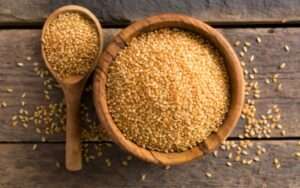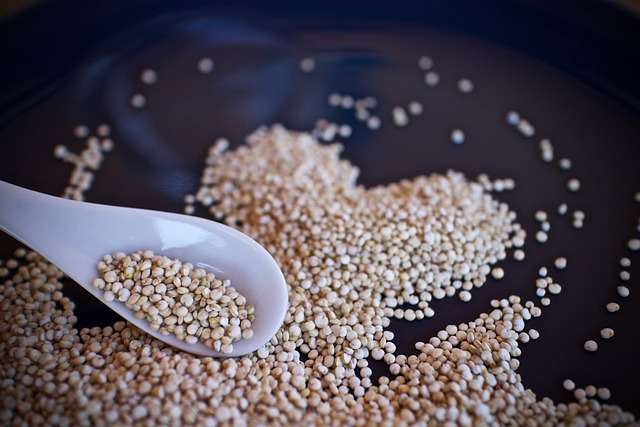Introduction:
Quinoa is a seed rather than a genuine grain. It is a member of the same family as spinach, Swiss chard, and beets, the Chenopodium. As Quinoa nutrition facts 1 Cup is the same as grains like rice, wheat, and oats, this qualifies quinoa as a pseudo-cereal.
Quinoa comes in several variations, the most popular of which are white, red, and black. Each variety’s flavor, texture, and nutrient composition vary somewhat. For anyone with celiac disease or gluten sensitivity, quinoa is a fantastic option because it is naturally gluten-free.
To prepare quinoa, it is often extensively rinsed to get rid of its saponin natural coating, which can have a bitter flavor. Cooked quinoa has a mild flavor and a light texture; it is boiled and cooked in water or broth until the liquid is absorbed and the grain is tender.

Quinoa Nutrition Facts 1 Cup:
Quinoa Nutrition Facts 1 Cup Calories
Depending on the variety of quinoa and the cooking process, Quinoa nutrition facts 1 Cup (185 grams) of cooked quinoa may vary slightly, but an average serving of cooked quinoa has about 222 calories. This calorie value is for quinoa that has only been cooked in water with no other additives or spices.
Carbohydrates
Quinoa is a food that is high in carbohydrates, with a serving size of 1 cup having roughly 39 grams of carbohydrates. Complex carbs, such as starch and dietary fiber, make up the majority of these carbohydrates. Blood sugar levels are stabilized and a steady source of energy is provided by complex carbs.
Protein
Quinoa, particularly in plant-based dishes, is renowned for its high protein content. About 8 grams of protein in Quinoa nutrition facts 1 Cup is included. Quinoa is unique among other plant protein sources since it is a complete protein and has all nine necessary amino acids. Because of this, quinoa is a fantastic option for vegetarians and vegans who wish to get enough protein.

Dietary fiber
When cooked, quinoa has roughly 5 grams of dietary fiber per cup. Dietary fiber fosters a sensation of fullness, which aids in weight control, and helps regulate bowel movements, prevents constipation, all of which are vital for digestive health.
Fat
Quinoa has a low fat content. The amount of fat in a cooked 1-cup serving of quinoa is roughly 3.5 grams. Most of these fats are monounsaturated and polyunsaturated fats, which are thought to be beneficial for the heart. For people who want to consume less saturated fat, quinoa is a wonderful option.
Vitamins
Such as the B vitamins: Numerous B vitamins, including B1 (thiamine), B2 (riboflavin), B3 (niacin), B6 (pyridoxine), and folate (B9), are among the vitamins found in quinoa. These vitamins are crucial for red blood cell production, energy metabolism, and cellular health in general. Quinoa is a grain that can help you acquire a variety of B vitamins in your diet.
Minerals
Quinoa is a good source of important minerals including magnesium and iron. Around 118 milligrams of magnesium, a mineral necessary for bone health as well as muscle and nerve function, are normally present in one cup of cooked quinoa. It also has roughly 2.8 milligrams of iron, which is necessary for the blood’s oxygen transport system and for preventing iron deficiency anemia.
Health Benefits of Quinoa:
Due to its outstanding nutritional profile, Quinoa Nutrition Facts 1 Cup offers a variety of health advantages. Here are quinoa’s top five health advantages:

Excellent Protein Sources
Quinoa is a complete protein source since it is one of the few plant-based foods to contain all nine essential amino acids. For vegetarians and vegans who may find it challenging to obtain all the necessary amino acids from their diet, this is especially advantageous. Protein is crucial for immune system health, immune system function, and general body growth and maintenance.
High Nutrient Density
Quinoa has a high nutrient density and is a good source of important vitamins and minerals like iron, magnesium, and B vitamins. Consuming meals rich in nutrients, such as quinoa, promotes overall health and vigor and supplies necessary vitamins and minerals for a variety of biological processes.
Rich in Dietary Fiber
Rich in Dietary Fiber Quinoa is high in dietary fiber, which helps with digestion, encourages regular bowel movements, and keeps you feeling full. Those who desire to better their digestive health or control their weight may find this to be extremely helpful.
Heart Health
Quinoa is an excellent source of heart-healthy fiber. It has heart-healthy unsaturated fat and less saturated fat. Quinoa’s blend of fiber, magnesium, and potassium aids in blood pressure regulation and lowers the risk of cardiovascular disease. In addition, quinoa’s antioxidant content may support general heart health.
Gluten-Free Option
Given that grain is inherently gluten-free, quinoa is an excellent option for people with celiac disease or gluten intolerance. It can be a wholesome and filling substitute for grains like wheat, barley, and rye that contain gluten.
Weight Management
Quinoa’s high protein and fiber content makes it a good food for managing weight. Protein and fiber make you feel full and satisfied, which lowers your risk of overeating or between-meal snacking.
How to incorporate Quinoa into Diet:
Quinoa is simple and diverse to include in your diet. Here are some ways to incorporate quinoa into your diet:
- Quinoa Salad: To make a tasty and nourishing salad, combine cooked and cooled quinoa with fresh vegetables such as cucumbers, tomatoes, bell peppers, and herbs. Vinaigrette dressing can be added for flavor.
- Quinoa Bowl: A quinoa bowl can be used to create a balanced meal. Add a lean protein, such as beans, tofu, or grilled chicken, to the cooked quinoa as a basis. Avocado, roasted or steamed veggies, and your preferred dressing or sauce should be added.
- Quinoa Breakfast: Use quinoa as a nutritious alternative for breakfast. It is cooked with milk or a milk replacement, sweeteners like honey or maple syrup, and fruit, nuts, and seeds are sprinkled on top. It produces a filling and wholesome porridge.
- Quinoa Stir Fry: In your stir fry recipes, use quinoa instead of rice or noodles. For a balanced dinner, sauté vegetables, protein, and your favorite sauce before adding cooked quinoa.
- Quinoa Stuffed Peppers or Squash: Stuffed with quinoa and vegetables, bell peppers, acorn squash, or zucchini are tasty options. For a tasty and wholesome lunch, bake the meat until it is soft.
FAQs:
1. Is quinoa a seed, or a grain.
Quinoa is not a grain; it is a seed.
- Is quinoa free of gluten?
Quinoa does indeed inherently lack gluten.
- How is quinoa prepared?
Rinse 1 cup of quinoa, then cook it in 2 cups of water for about 15 minutes, or until the water is completely absorbed.
4. Can you get a complete protein from quinoa?
Quinoa contains all nine of the essential amino acids, making it a complete protein.
- What distinguishes white, red, and black quinoa from each other?
Aside from modest changes in flavor and texture, the nutritional profiles of white, red, and black quinoa are very similar.
Conclusion:
In summary, quinoa is an exceptional and adaptable pseudo-cereal that provides a variety of nutritional advantages. It is a beneficial complement to a balanced diet because it is a complete protein, gluten-free, and rich in vital vitamins and minerals.
Quinoa Nutrition Facts 1 Cup is a healthy option that keeps rising in popularity in contemporary cuisine, whether you want to increase your protein consumption, improve digestive health, or simply enjoy a delicious and nutritious meal. Including quinoa in your diet can improve your health overall and increase your love of food. Click to learn more.
